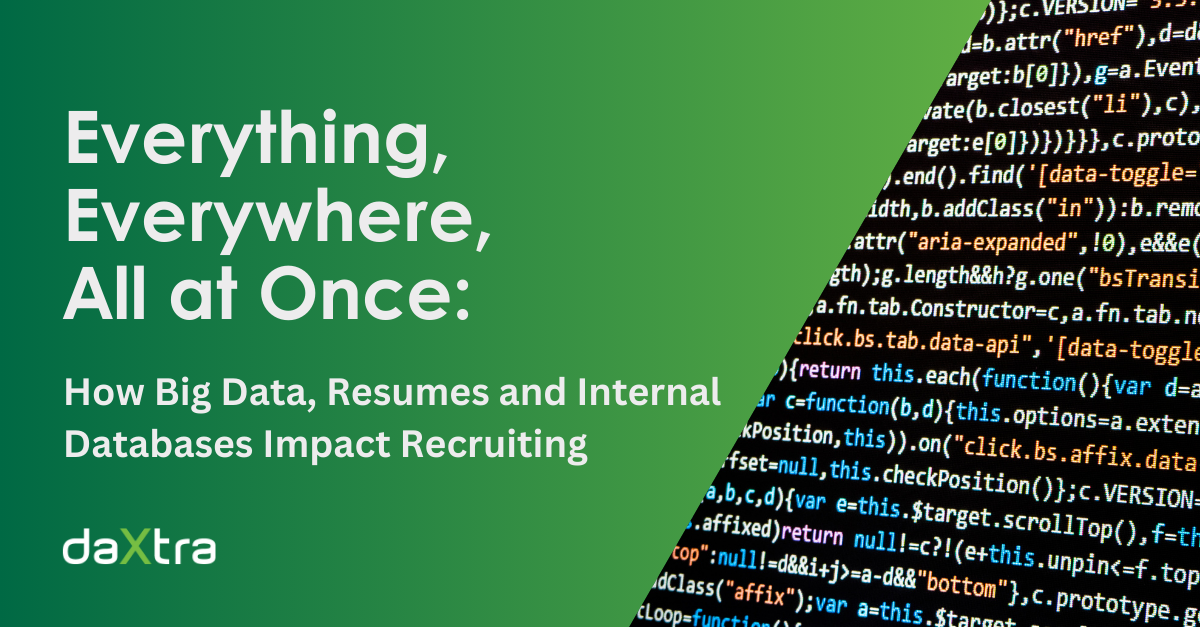Recruiters everywhere are focusing on the power of candidate data, and it's an undeniable part of the recruiting and hiring process today. From resumes to social media to notes in your internal database, candidate data is everything, it's everywhere, and it's happening all at once.
But, did you know that different data sources can play different roles in recruiting? Depending on where it's from, candidate data can provide valuable information for different parts of your workflows.
Because of this, there are several ways that candidate data can change the way recruiters work, make decisions and find top talent.
Where can you find top talent?
Resumes and CVs
Resumes are the most traditional and direct way to learn about candidates. They’re a direct window into a candidate’s contact information, work experience, skills, education, and interests. They’re structured and generally very reliable, making initial candidate screening efficient.
Regularly engaging with candidates can help ensure you update resume data to keep your database fresh, accurate and up-to-date.
Big Data
What is big data? Google defines it as “extremely large and diverse collections of structured, unstructured and semi-structured data that grow exponentially over time.”
In recruiting terms, this can refer to data from social media, job boards, career websites or other online sources. It encompasses social media and everything else related to each candidate from multiple places online, for millions of candidates around the world, amounting to a truly enormous amount of information.
When streamlined and organized, this level of data can round out a more complete picture of a particular candidate. But, because big data is so vast, unorganized and unstructured, effectively using it for a business is a huge task. It requires tools and personnel to effectively find, parse, store, organize, process and analyze it.
Internal Databases
Internal databases, like your ATS or CRM, are where all of your data comes together. You can store data from resumes and CVs, supplement that with insights gathered from big data, and see all of your colleagues' notes, interactions and other touchpoints with each candidate in one place.
In particular, seeing past candidate interactions and feedback can be a goldmine for future insights, and allow recruiters to build valuable, long-term relationships with each candidate—leading to better engagement and even more potential for placements in the long run.
The Role of Data in Recruiting
Each source of data has different strengths, but they all play a role in the recruiting process. With so much information available, it’s important to prioritize what information is most valuable to your recruiting efforts. Some recruiters may prioritize new resumes or CVs to build candidate data, others might focus on building their internal database and supplementing it with big data from social media or career sites.
Regardless of how you prioritize it, candidate data can be very useful in recruiting, beyond just finding the best candidates. Here are a few ways recruiters can leverage candidate data to improve recruitment processes:
Analyzing Candidate Trends
Resumes advertise candidates’ strengths and qualifications. By consistently extracting and organizing this data, you can monitor market trends in skills and their supply and demand. This analysis can allow you to shape your hiring strategy more effectively and round out any big data you’re leveraging with your own tailored datasets.
Powering Business Intelligence
Data about a candidate's experience provides detailed insights into a candidate’s skills and their previous employer’s growth strategies and projects. Extracting this data and feeding it into your CRM can enhance predictive analytics and lead-generation efforts, which inform overall business intelligence, in addition to your day-to-day recruiting efforts.
Enhancing Job Advertising
With access to a vast amount of this kind of structured candidate data about what kinds of skills and opportunities candidates have, recruiters are better empowered to target their advertised opportunities to candidates that will be good fits for particular positions. In the long run, this kind of personalization can increase the effectiveness of your job-filling efforts.
Tracking Candidate Sources
Source mis-attribution can be a serious problem for recruiters. If you don’t know where your candidates are coming from, it’s much harder to prioritize spend or see what tools are working. So, ensuring that you accurately track candidate sources is essential to building a recruiting strategy and keeping an active pipeline of clean candidate data.
Tips for Recruiters to Get More Out of Data
- Automating Data Extraction: Resume data doesn’t go far if it isn’t in your database. Luckily, this process can be automated to free up recruiters from tedious busy work. Resume parsing solutions can automate this process, delivering accuracy and detail comparable to human administrators, regardless of the resume's language or format.
“It’s common for us to talk to someone who did a data clean-up project last year and plans to do another clean-up project the following year, but in-between didn’t do anything to solve for the bad data that made it into the system in the first place. One of the biggest impacts tech can have is putting guardrails on data management strategies to automate those manual processes and take the decision out of a recruiter’s hands. That way, they don’t have to think about “Do I load this candidate into the database or not?” — you can set up automated processes so the candidate info is already funneled in, without duplicates.” - Chris Wirt, Daxtra
- Data Integration: Efficient storage and organization makes it easier to integrate different data from different sources. With resumes, notes and feedback and supplementary big data, recruiters can build a more complete, 360-degree view for each candidate they’re working with. This can have an effect that snowballs out to the efficacy of your candidate engagement and placements down the line.
- Continuous Learning: Data is always changing. By staying up-to-date on the latest trends and tools in recruiting data, teams will be better equipped to manage both existing data and new incoming data in the future.
Insights for Success
In today’s recruiting world, data is more important (and more available) than ever. That means that each piece of data about candidates can not only provide value to your business but also empower your recruiters to more easily place those candidates in their dream jobs.
Resumes, big data and internal databases all play crucial roles in modern recruiting, offering valuable insights and essential information to inform hiring decisions. With careful consideration, the right tools and ongoing education, recruiters can make the most of each of them.



